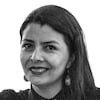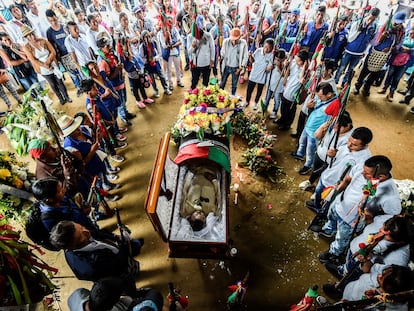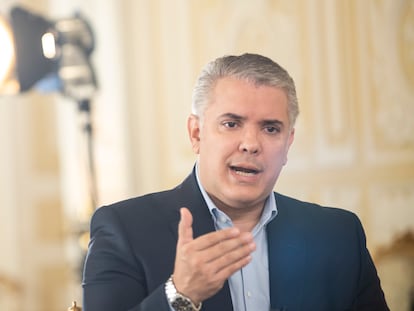The young Colombian whose identity was confirmed 15 years later
The family of Francisco Javier had been praying in front of a cemetery niche without knowing if it contained the body of their son, who died during fighting between the army and the FARC guerrilla

For 15 years, the family of Francisco Javier Buitrago Quiceno prayed in front of niche 43 at the cemetery in Samaná, a small town in Colombia’s Magdalena Medio region, in the department of Caldas. But they were not really sure if the body that lay there really belonged to the young man who died when an explosive device went off in the middle of a fight between the army and guerrillas.
It took a peace process that created a Search Unit for People Given Up as Disappeared (UBPD), 300 exhumations in cemeteries across the region and 120 DNA tests to end the family’s lack of certainty. On Saturday, they received the youth’s identified body and gave him a proper burial, as they had been wanting to do for the last two decades. Quiceno was the first victim to be identified among the hundreds of thousands that the unit is searching for along with the Special Jurisdiction for Peace (JEP), following the peace agreement between the Colombian government and the now-dissolved FARC guerrilla.
Quiceno’s relatives took the coffin and photographs of the young man down the streets of town. “It was also a historic event in that sense, to clean the name of many people who were killed, made to disappear, brought to these cemeteries and placed in niches as unidentified individuals, without a name, without dignity, without a history or a family. It’s worth it because we found the truth,” said Carolina López Giraldo, of the Center for the Study of Conflict, Violence and Social Harmony (Cedat).
Samaná is a town of 22,000 residents that was greatly affected by the armed conflict. According to the national victim register, 85% of its population has had a family member killed, wounded by mines or disappeared. For years, it was the battleground for fighting between FARC groups led by a man nicknamed Karina and paramilitary units headed by Ramón Isaza. The local population was stuck in the middle.
Francisco Javier’s story took place against this backdrop. According to his relatives, he was working on his uncle’s farm when an explosive device fell on the property, killing him and another young man, on a day when the Colombian army was fighting the guerrilla. The bodies, said the family, were taken away by the military and buried in numbered niches at San Agustín cemetery in Samaná.
The boy’s father turned to several agencies for help but got no reply. It was the undertaker who helped him in the end: the father explained the clothes his son was wearing and the date of his death, and the cemetery worker told him that the body was lying in niche 43. Francisco Javier’s father wrote his son’s name on it.
Colombia is a country where a lot of people have been given the wrong body back, or who are praying at the wrong grave. It happened at the massacre of Bojayá, in May 2002, when guerrilla shelling killed around 100 people inside a church. That is why it was natural for Quiceno’s family to harbor doubts about the identity of the body they were praying to.
“When they told us they’d identified him, my family was very glad because we were not certain that it was him. Personally, I am feeling very calm now,” said Jesús Quiceno, the victim’s uncle and the owner of the land where he died. The property was destroyed and he was forced to flee along with the rest of the family members.
In 2020, forensic experts from UBPD with support from JEP exhumed 24 bodies in Samaná. One of them was the body of a 21-year-old man whose remains showed evidence of explosive-related trauma. Researchers went to see the parents and collected DNA samples from them – the couple was too frail to travel into town. The Institute for Legal Medicine and Forensic Science later analyzed the samples and found a match.
The finding, said UBPD director Luz Marina Monzón, represented years’ worth of efforts by the family and civil society groups. Five other identified bodies are going to be returned to their loved ones. But Francisco Javier had two brothers who went missing in 2005, so the family’s sense of relief is incomplete. Their uncle said that the search must continue: “If we found this one, let’s keep looking for Duberney and Rubén, whether they’re dead or alive.”
Tu suscripción se está usando en otro dispositivo
¿Quieres añadir otro usuario a tu suscripción?
Si continúas leyendo en este dispositivo, no se podrá leer en el otro.
FlechaTu suscripción se está usando en otro dispositivo y solo puedes acceder a EL PAÍS desde un dispositivo a la vez.
Si quieres compartir tu cuenta, cambia tu suscripción a la modalidad Premium, así podrás añadir otro usuario. Cada uno accederá con su propia cuenta de email, lo que os permitirá personalizar vuestra experiencia en EL PAÍS.
¿Tienes una suscripción de empresa? Accede aquí para contratar más cuentas.
En el caso de no saber quién está usando tu cuenta, te recomendamos cambiar tu contraseña aquí.
Si decides continuar compartiendo tu cuenta, este mensaje se mostrará en tu dispositivo y en el de la otra persona que está usando tu cuenta de forma indefinida, afectando a tu experiencia de lectura. Puedes consultar aquí los términos y condiciones de la suscripción digital.
More information
Últimas noticias
Pinochet’s victims grapple with José Antonio Kast’s rise in Chile
Reinhard Genzel, Nobel laureate in physics: ‘One-minute videos will never give you the truth’
How Japan is trying to avert ‘digital defeat’
The complicated life of Francesca Albanese: A rising figure in Italy but barred from every bank by Trump’s sanctions
Most viewed
- Pablo Escobar’s hippos: A serious environmental problem, 40 years on
- Why we lost the habit of sleeping in two segments and how that changed our sense of time
- Charles Dubouloz, mountaineering star, retires at 36 with a farewell tour inspired by Walter Bonatti
- Trump’s obsession with putting his name on everything is unprecedented in the United States
- The Florida Keys tourist paradise is besieged by immigration agents: ‘We’ve never seen anything like this’










































